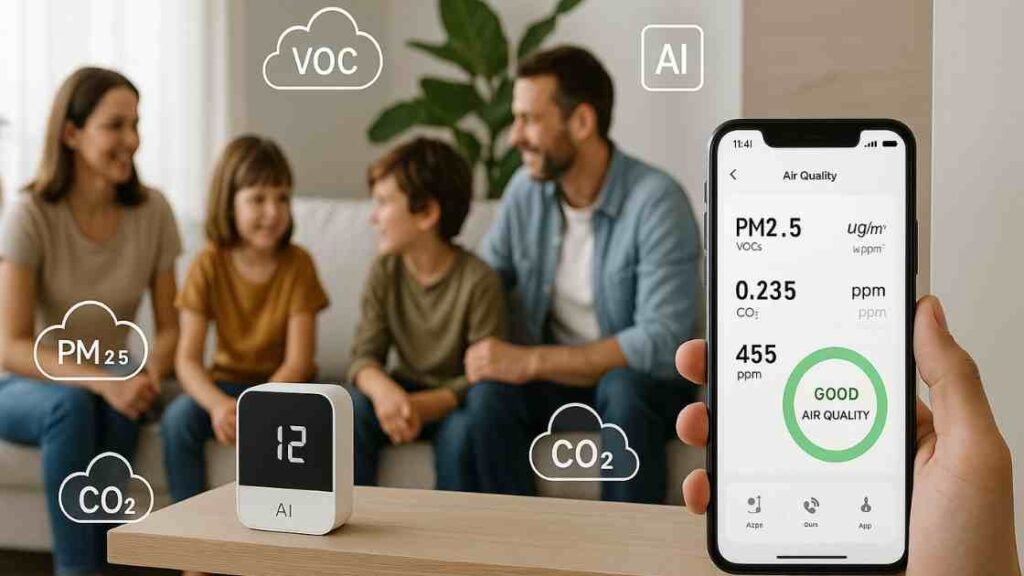AI Gadgets for Monitoring Indoor Air Quality: Breathe Easier at Home
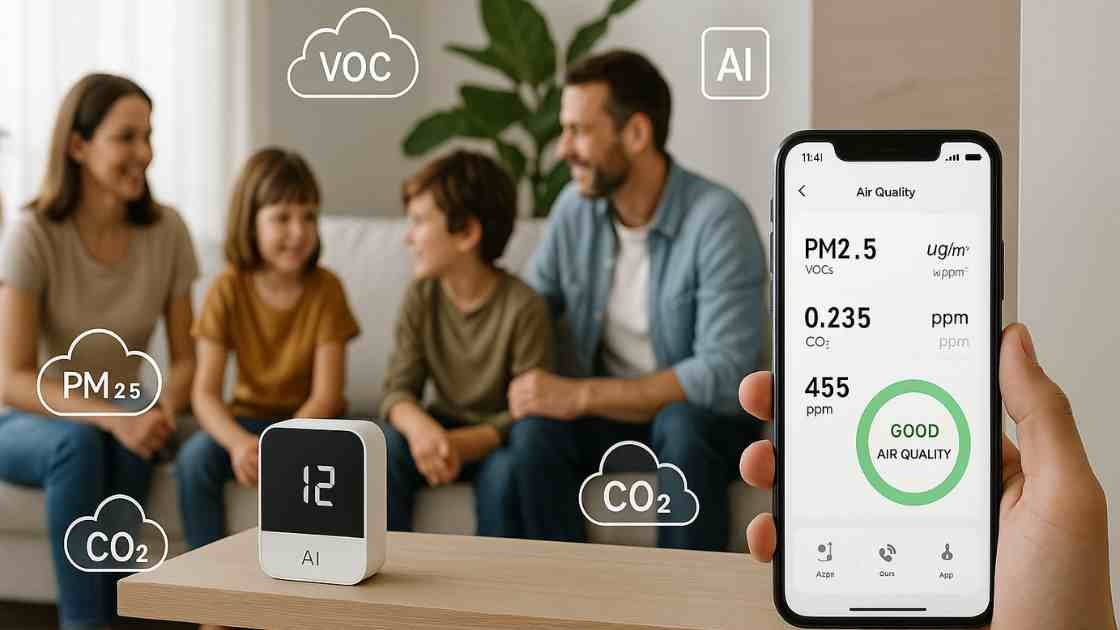
In today’s connected world, where we spend most of our time indoors, the quality of the air we breathe plays a major role in our health, comfort, and overall well-being. Studies by the World Health Organization (EPA) reveal that indoor air can sometimes be two to five times more polluted than outdoor air. That means the air inside your home or office could be quietly harming your lungs, skin, and sleep quality — without you even realizing it.
Invisible pollutants such as dust, VOCs (volatile organic compounds), mould spores, carbon monoxide, and fine particulate matter (PM2.5) can accumulate in poorly ventilated spaces. Over time, they may trigger allergies, fatigue, asthma, or more serious respiratory conditions.
This is where AI air quality monitors make a remarkable difference. These next-generation devices combine artificial intelligence, smart sensors, and machine learning algorithms to track, analyze, and even predict air quality changes in real time. Unlike traditional air monitors, AI-powered gadgets don’t just show numbers — they learn from your environment and offer actionable insights to improve your indoor air.
From alerting you about elevated CO₂ levels to automatically adjusting your air purifier through smart home integration, AI air quality monitors empower you to take control of your environment. They help you breathe cleaner, fresher air every day — transforming your home into a healthier, safer space for your family.
In this guide, we’ll explore everything you need to know about AI air quality monitors — how they work, what makes them different, the best models available in the UK, and how they’re shaping the future of indoor wellness.
Understanding Indoor Air Quality (IAQ)
Before diving into how AI air quality monitors work, it’s important to understand what indoor air quality really means — and why it matters so much for your health.
Indoor Air Quality (IAQ) refers to the condition of the air inside enclosed spaces such as homes, offices, schools, or public buildings. It is influenced by multiple factors, including ventilation, humidity, building materials, and everyday human activities like cooking, cleaning, and using appliances. Poor IAQ doesn’t just make a space feel stuffy — it can directly affect concentration, mood, and long-term respiratory health.
According to the Environmental Protection Agency (EPA), indoor air pollution is among the top five environmental risks to public health. The pollutants that accumulate indoors often come from common sources, and because most modern buildings are tightly sealed for energy efficiency, those pollutants have fewer chances to escape.
Common Indoor Air Pollutants
AI-powered monitors detect a wide range of pollutants that impact your health and comfort. The most frequent culprits include:
| Pollutant | Common Sources | Possible Health Effects |
|---|---|---|
| Particulate Matter (PM2.5 & PM10) | Smoke, cooking fumes, dust, candles, traffic emissions | Coughing, breathing difficulty, cardiovascular stress |
| Volatile Organic Compounds (VOCs) | Paints, furniture varnish, cleaning sprays, adhesives | Headaches, dizziness, long-term toxicity |
| Carbon Monoxide (CO) | Gas stoves, heaters, fireplaces | Fatigue, nausea, severe poisoning in high exposure |
| Carbon Dioxide (CO₂) | Human respiration, poor ventilation | Drowsiness, loss of focus, low productivity |
| Nitrogen Dioxide (NO₂) | Gas ovens, car exhaust entering indoors | Airway inflammation, worsening of asthma |
| Radon Gas | Soil and building foundations | Major cause of lung cancer in non-smokers |
| Mould & Spores | Damp areas like basements, bathrooms | Allergic reactions, chronic sinus issues |
| Pet Dander & Pollen | Pets, plants, outdoor air | Sneezing, irritation, allergic asthma |
While these pollutants may seem harmless individually, their combined presence can significantly degrade indoor air quality — especially in tightly insulated homes or high-traffic urban areas.
Why Indoor Air Quality Monitoring Matters
This is where AI air quality monitors play a vital role. Continuous monitoring of indoor air gives you the knowledge and tools to take timely action. Some key benefits include:
- Health Protection: Detecting and reducing exposure to harmful gases and particulates lowers the risk of respiratory diseases, allergies, and fatigue.
- Comfort & Productivity: Clean, oxygen-rich air improves focus, mood, and sleep quality.
- Early Detection: AI sensors can alert you when pollutant levels rise unexpectedly — before symptoms appear.
- Informed Decision-Making: Real-time data empowers you to decide when to ventilate, purify, or adjust humidity.
- Regulatory Compliance: For workplaces or schools, monitoring ensures compliance with health and safety standards.
By pairing environmental science with intelligent algorithms, AI air quality monitors help you not only see what’s in your air but understand how to manage it effectively.
How AI Enhances Air Quality Monitoring
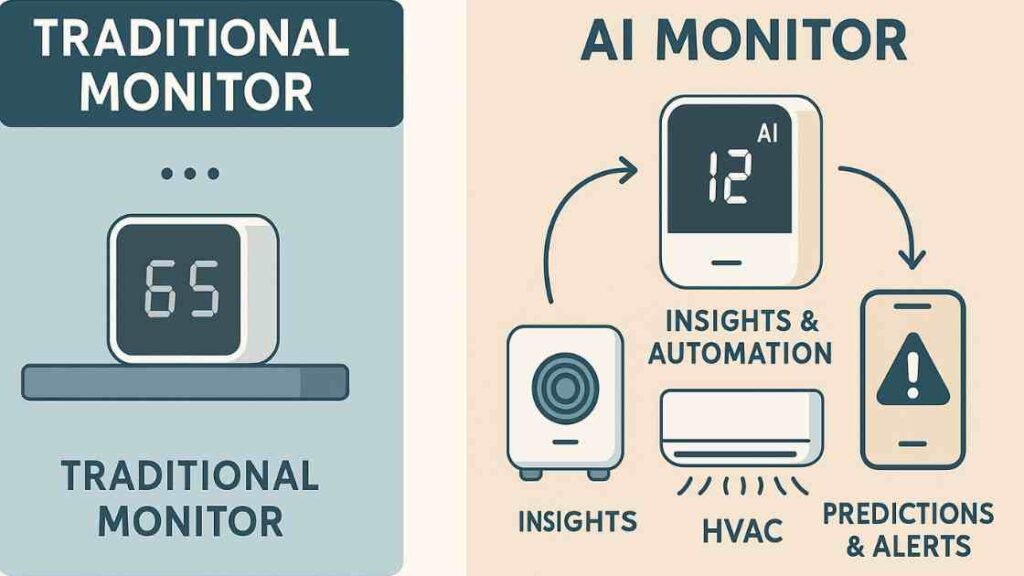
The leap from traditional air monitors to AI air quality monitors represents one of the most meaningful advancements in smart home technology. While conventional devices simply display pollutant levels, AI-powered systems actually think, learn, and act — turning raw air data into intelligent environmental insight.
From Passive Measurement to Predictive Intelligence
Traditional air monitors use basic sensors to detect limited pollutants such as PM2.5 or CO₂. They collect data, but they don’t interpret it. You might see a red or green light indicating air quality, yet the device can’t explain why the air changed or what you can do about it.
AI air quality monitors, on the other hand, function like a personal environmental assistant. They combine sensor networks with artificial intelligence and machine learning algorithms that continuously learn from your indoor conditions. Over time, they recognize patterns — such as pollution spikes during cooking or cleaning — and adapt to your lifestyle.
These monitors don’t just tell you that your air is bad; they tell you why and how to fix it. For example, the system might notify you that VOC levels increase each time you spray air freshener, or that your CO₂ levels rise sharply during closed-window nights, suggesting the need for ventilation.
Traditional Monitors vs. AI-Powered Monitors
| Feature | Traditional Air Monitor | AI Air Quality Monitor |
|---|---|---|
| Pollutants Tracked | Limited (PM2.5, CO₂) | Comprehensive (PM2.5, PM10, VOCs, CO₂, NO₂, humidity, temperature) |
| Data Processing | Static readings | Real-time AI data interpretation |
| Learning Capability | None | Machine learning improves accuracy and personalization |
| Predictive Analysis | Not available | Forecasts upcoming air quality trends |
| Smart Home Integration | Manual control | Syncs with purifiers, HVAC systems, Alexa, Google Home |
| User Guidance | Basic alerts | Tailored insights and health-based recommendations |
This transformation makes AI devices proactive instead of reactive — they don’t wait for problems to occur; they anticipate them.
Key AI Features That Transform Air Quality Monitoring
- Machine Learning for Adaptive Intelligence
AI algorithms continuously refine their understanding of your environment. They compare thousands of sensor readings to predict when air quality might drop — for instance, before you even notice odours or stuffiness. - Predictive Data Analytics
By analyzing historical patterns, AI air quality monitors can forecast pollution surges based on time of day, weather, humidity, or occupancy. This allows users to take preventive steps, such as activating purifiers before the air worsens. - Sensor Fusion Technology
Instead of relying on a single reading, AI monitors merge data from multiple sensors — temperature, humidity, particulate matter, VOCs, and gases — to build a complete environmental profile. This fusion reduces false readings and enhances precision. - Natural Language Processing (NLP) and Voice Feedback
Some advanced models integrate NLP, allowing you to ask, “How clean is my air right now?” or “What should I do to improve air quality?” The monitor responds with simple, human-like explanations rather than technical numbers. - Smart Home Automation
AI devices seamlessly connect with other smart systems — such as air purifiers, dehumidifiers, or smart thermostats — to automatically adjust airflow and filtration based on current air conditions. If CO₂ rises, your ventilation system turns on without you lifting a finger. - Continuous Self-Calibration
Over time, sensors may drift slightly in accuracy. AI automatically calibrates them using environmental baselines, maintaining consistent reliability without manual intervention.
The Real-World Impact of AI-Driven Air Quality Monitoring
The integration of AI transforms air monitoring into a real-time, self-learning ecosystem. Instead of overwhelming users with raw data, these smart gadgets interpret environmental signals through context — your habits, your home layout, even seasonal variations.
For instance:
- During winter, when windows stay closed, the system might suggest brief ventilation intervals to balance humidity and reduce CO₂ buildup.
- In high-pollution cities, AI may recommend activating your purifier an hour earlier, based on forecasted outdoor air quality trends.
This synergy of data, automation, and predictive intelligence is what truly differentiates AI air quality monitors from traditional sensors — making them a cornerstone of modern, healthy living.
AI air quality monitors use machine learning and real-time analytics to turn sensor data into actionable insights that help you manage pollutants before they become a problem.
For readers interested in the deeper technology behind these systems, see the detailed research article How Artificial Intelligence is Transforming Air Quality Monitoring.
Top AI Air Quality Monitors in the UK
As more people focus on creating healthier homes, AI air quality monitors have become vital companions in smart living. These intelligent gadgets combine real-time sensors, AI-driven analytics, and smart-home integration to help you maintain cleaner, safer indoor air. Below are three of the best options available in the UK — each reviewed in detail to match different needs, spaces, and budgets.
🟩 1. Dyson Purifier Humidify + Cool Formaldehyde (PH04)
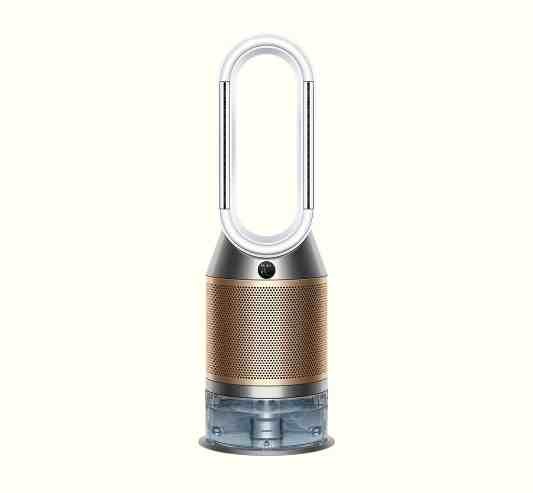
The Dyson Purifier Humidify+Cool Formaldehyde (PH04) redefines what an air monitor can do. It doesn’t just track pollutants—it actively purifies, cools, and humidifies the air while learning your home’s unique environment through built-in AI sensors.
It automatically detects pollutants like PM2.5, VOCs, and NO₂, adjusting filtration speed based on real-time air quality data. The real-time LCD display and the MyDyson™ app keep you informed of pollutant levels, humidity, and temperature. The Dyson PH04 features an exclusive catalytic filter that constantly destroys formaldehyde by breaking it down into small amounts of water and CO₂, addressing one of the most persistent and difficult-to-remove indoor toxins.
Key Features
- 3-in-1 Functionality: Purifier, fan, and hygienic humidifier for year-round comfort.
- AI-Powered Sensors: Automatically detect and adjust to changes in air quality.
- Formaldehyde Elimination: Unique catalytic filter continuously breaks down harmful gases safely.
- Smart Connectivity: MyDyson™ app with live air-quality insights and remote control.
- LCD Display: Real-time IAQ data including PM2.5, humidity, and temperature.
- Hygienic Humidification: Ultraviolet Cleanse technology kills 99.9% of bacteria in the water before projection.
Pros & Cons – Dyson Purifier Humidify+Cool Formaldehyde (PH04)
| Category | Details |
| Pros | • 3-in-1 performance: purifier, fan, and humidifier |
| • Automatic AI-based purification adjustment | |
| • Captures 99.95% of airborne particles (HEPA H13) | |
| • Destroys formaldehyde—a unique and permanent feature | |
| • Excellent build quality and modern aesthetic | |
| Cons | • Higher cost compared with basic air monitors |
| • Filter replacements are expensive | |
| • Takes up moderate space in small rooms | |
| Best For | Health-focused homeowners or allergy sufferers who want complete smart-home automation and purification. |
| Price Range (UK) | £649 – £699 |
| Official Page | Dyson UK – Purifier Humidify+Cool Formaldehyd |
🟦 2. Awair Element Smart Air Monitor
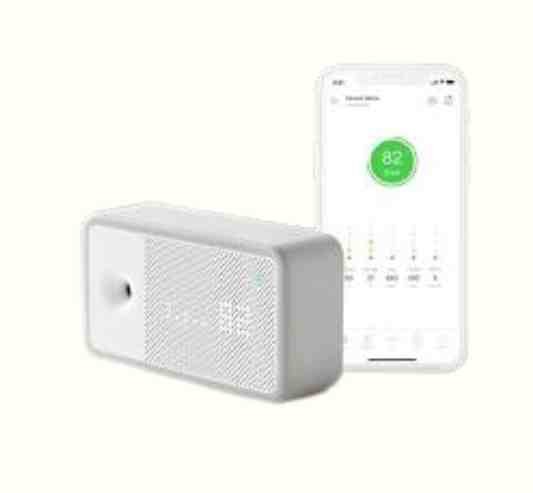
The Awair Element is one of the most accessible AI air quality monitors for everyday users who want professional-grade insights without paying premium prices. It continuously tracks five major environmental factors — PM2.5, CO₂, VOCs, temperature, and humidity — and uses machine learning to interpret fluctuations in real time.
The Awair Home App visualizes indoor air data through simple color-coded scores while providing personalized AI suggestions for improvement, such as “Open a window” or “Reduce indoor humidity.” Integration with Alexa, Google Home, and IFTTT makes it easy to connect with other smart-home devices for automated air control.
Key Features
- Comprehensive Detection: Monitors PM2.5, VOCs, CO₂, temperature, and humidity.
- AI Insights: Machine learning provides custom tips to improve air quality.
- App Integration: Awair Home App displays real-time data and long-term trends.
- Smart Compatibility: Works with Alexa, Google Home, and IFTTT for automation.
- Minimalist Design: Compact, stylish body that blends into any home decor.
- Data Visualization: Color-coded air health score for easy readability.
Pros & Cons – Awair Element Smart Air Monitor
| Category | Details |
|---|---|
| Pros | • Affordable entry into AI-powered air quality monitoring • High accuracy for PM and CO₂ detection • Attractive and minimalist design • Simple app interface with long-term trend tracking • Smart-home compatibility enhances automation |
| Cons | • Does not purify air — monitoring only • Requires constant Wi-Fi connectivity • App alerts can lag slightly if offline |
| Best For | Apartments, small homes, or offices needing real-time IAQ tracking and data visualization |
| Price Range (UK) | £145 – £179 |
| Buy From | Awair Element Smart Air Monitor – Amazon UK |
🟠 3. Airly Pro Smart Environmental Monitor (Advanced Analytics)
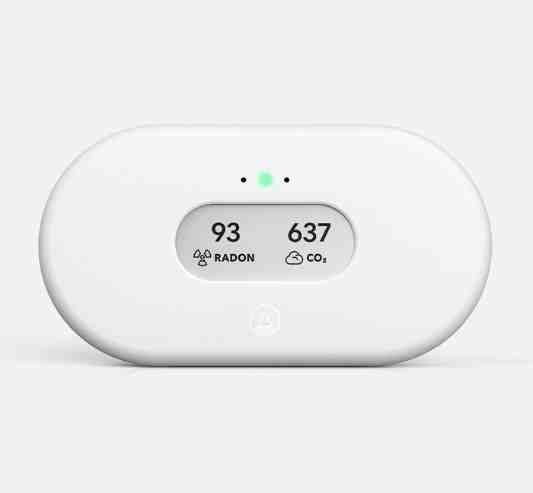
Designed for data-driven users, offices, and environmental research, the Airly Pro Smart Environmental Monitor excels at bridging indoor and outdoor intelligence. While Airly’s main focus is large-scale outdoor and professional monitoring networks, this AI-driven device offers a suite of sensors unparalleled in the consumer space.
The Airly Pro continuously tracks up to nine environmental parameters—including PM1, PM2.5, PM10, CO₂, NO₂, O₃, temperature, and humidity—allowing for professional-grade analysis. Its powerful, cloud-based AI prediction engine is its standout feature, analyzing regional air patterns to forecast future air quality. By combining local weather, outdoor pollution trends, and real-time indoor data, it proactively warns you about potential pollution spikes hours in advance.
With Google Assistant and Home Assistant integration, the Airly Pro can be used to automatically control ventilation or air purifiers, making it one of the most advanced predictive AI air quality monitors available for those willing to manage a slightly more complex, data-focused system.
Key Features
- Multi-Pollutant Detection: Measures PM1, PM2.5, PM10, CO₂, NO₂, and O₃ simultaneously.
- AI Prediction Engine: Forecasts future air quality based on comprehensive environmental data.
- Cloud Connectivity: Secure data upload and long-term analysis via Airly Cloud.
- Smart-Home Integration: Works with Google Assistant and Home Assistant systems.
- Professional-Grade Data: Ideal for research, large homes, or businesses requiring high-detail environmental reports.
Pros & Cons – Airly Pro Smart Environmental Monitor
| Category | Details |
| Pros | • Tracks one of the widest pollutant ranges on the market (including NO₂ and O₃) |
| • AI-powered prediction model warns before pollution spikes occur | |
| • Seamless integration with advanced smart-home devices | |
| • Cloud analytics improve accuracy over time | |
| Cons | • Primarily designed for professional use; setup can be complex for beginners |
| • Subscription likely required for full, long-term data access and advanced analytics | |
| • No built-in purification (monitoring only) | |
| Best For | Tech-savvy users, researchers, and commercial spaces seeking detailed, predictive, professional-level IAQ insights. |
| Price Range (UK) | £249 – £299 (estimated device cost) |
| Learn More | Airly – Smart Environmental Monitoring |
🟢 4. Amazon Smart Air Quality Monitor (Newest Gen)
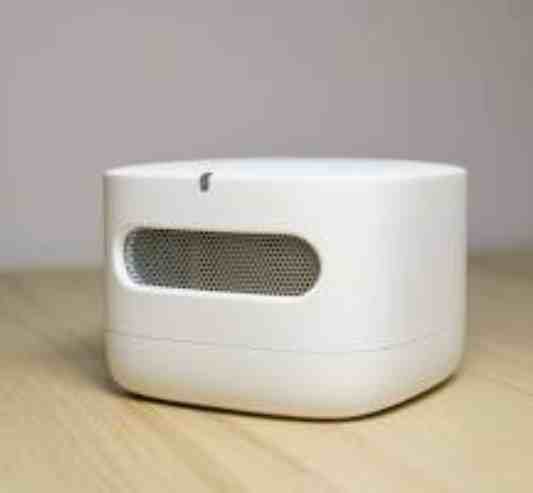
The Amazon Smart Air Quality Monitor provides a highly accessible and affordable entry point for smart home users. Its primary value lies not just in its sensors, but in its deep, seamless integration with the Alexa ecosystem to trigger automated air correction. It’s a monitor designed to be a trigger for other devices.
| Category | Detail |
| Monitors | PM2.5, VOCs, Carbon Monoxide (CO), Temperature, Humidity |
| Key Features | Alexa Integration: Provides voice-activated air quality reports via Echo devices. Automated Routines: Uses air quality readings (PM2.5, VOC, CO, etc.) as triggers to automatically activate compatible smart air purifiers, fans, or dehumidifiers. Visual Indicator: Color-coded LED ring provides a quick, at-a-glance air quality status (Good, Moderate, Poor). |
| Pros | Budget-Friendly: Highly affordable and an easy addition for existing Amazon users. Best Automation: Provides unmatched ease of use for creating simple, effective air-correction routines with compatible devices. Real-time Alerts: Sends notifications to your phone or Echo devices when air quality dips. |
| Cons | No CO₂ or Radon: Lacks detection for Carbon Dioxide (CO₂) and Radon, limiting its comprehensive health insight. Requires an Echo device for full voice control and announcements. Not a certified CO alarm replacement. |
| Best For | Households already using Amazon Echo/Alexa devices who want a cost-effective monitor to trigger simple, automated air correction routines based on PM2.5 or VOC spikes. |
| Price Range (UK) | ~£65 |
| Buy From | Amazon UK |
- Know your air: Amazon Smart Air Quality Monitor makes it easy to understand what’s in your indoor air.
- Track and measure 5 key factors: particulate matter (PM 2.5), volatile organic compounds (VOCs), carbon monoxide (CO), h…
- Stay informed: get an indication of current air quality from the colour-coded LED, and an easy-to-understand air quality…
🟣 5. Airthings View Plus
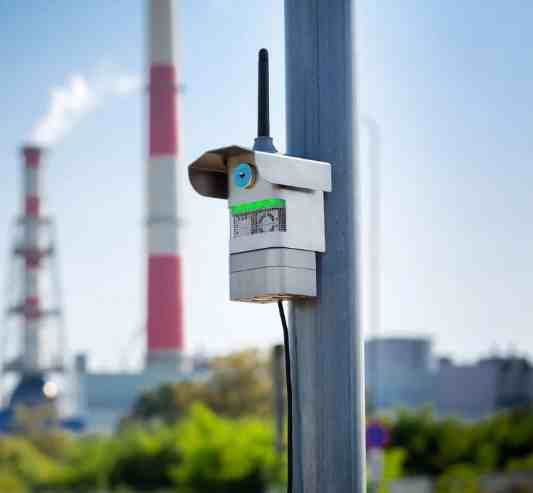
Designed for the health-conscious consumer, the Airthings View Plus is arguably the most comprehensive consumer-grade air quality monitor on the market. With seven distinct sensors, its core strength is providing expert-level data, including Radon and CO₂, in an accessible package that integrates with your smart home.
| Category | Detail |
| Monitors | Radon, PM2.5, Carbon Dioxide (CO₂)*, VOCs, Temperature, Humidity, Air Pressure |
| Key Features | 7 Always-On Sensors: Provides a holistic view of the indoor environment, including the difficult-to-detect Radon. E-Paper Display: Large, customizable display shows up to four key values simultaneously. Multiroom Hub: When plugged in, acts as a SmartLink Hub for other Airthings Wave monitors. Battery Option: Can run on batteries for up to 2 years for flexible, cable-free placement. |
| Pros | Comprehensive Health Data: Crucial detection of Radon (a long-term health risk) and CO₂ (affects concentration and sleep). In-Depth App: Provides clear graphs, historical trends, and actionable insights. Smart Compatibility: Works with Alexa, Google Assistant, and IFTTT to enable automated ventilation. |
| Cons | Premium Price: A significant investment, placing it at the high end of the monitor-only category. Requires an initial settling period for accurate CO₂ and Radon readings. |
| Best For | Health-focused homeowners seeking the most detailed environmental monitoring, especially those concerned about Radon and CO₂ levels, or those who need a central Hub for an ecosystem of Airthings sensors. |
| Price Range (UK) | ~£200 – £260 |
| Buy From | Airthings, B&Q, Currys UK |
- SEVEN, ALWAYS-ON SENSORS: WiFi connected indoor air quality monitor measuring radon gas, particulate matter (PM2.5), car…
- ACCURATE RADON DETECTOR: The digital radon detector uses passive diffusion chamber sampling with alpha spectrometry dete…
- FREE and FRIENDLY APP: Use the Airthings app to check current air quality readings and analyze trends over time, get tim…
💡 Choosing the Right AI Air Quality Monitor
When comparing these models, consider your needs, budget, and home size:
- For complete automation: Choose Dyson, which purifies and adjusts settings automatically.
- For practical affordability: Awair offers great AI analytics for smaller spaces.
- For advanced forecasting: Airly Pro provides professional-level environmental intelligence.
Regardless of your choice, all AI air quality monitors serve the same essential purpose — empowering you to monitor, predict, and improve indoor air health using smart, data-driven technology.
📊 Comparison Table: Best AI Air Quality Monitors in the UK (2025 Edition)
| Feature | 1. Dyson Purifier Humidify+Cool Formaldehyde (PH04) | 2. Awair Element Smart Air Monitor | 3. Airly Pro Smart Environmental Monitor | 4. Amazon Smart Air Quality Monitor (Newest Gen) | 5. Airthings View Plus |
| Price Range (UK) | £649 – £699 | £145 – £179 | £249 – £299 (estimated device cost) | ~£65 | ~£200 – £260 |
| Primary Function | Purifier, Humidifier, Fan, Monitor | Monitor Only | Monitor Only | Monitor Only | Monitor Only |
| Total Pollutants Monitored | 6 (PM2.5, NO₂, VOCs, Temp, Humidity, Formaldehyde) | 5 (PM2.5, CO₂, VOCs, Temp, Humidity) | 9 (PM1, PM2.5, PM10, CO₂, NO₂, O₃, Temp, Humidity, Pressure) | 5 (PM2.5, CO, VOCs, Temp, Humidity) | 7 (Radon, PM2.5, CO₂, VOCs, Temp, Humidity, Pressure) |
| Unique Detection | Formaldehyde (Catalytic Destruction) | CO₂ (High Accuracy) | NO₂, O₃, PM1, PM10 | Carbon Monoxide (CO) | Radon (Long-term health risk) |
| Key AI/Smart Feature | Automatic 3-in-1 Adjustment; Formaldehyde Destruction | AI Personalized Improvement Tips | AI Predictive Forecasting (Outdoor/Indoor) | Alexa Routines Automation Trigger | SmartLink Hub Functionality; Detailed Radon Analysis |
| Best For | Premium health-focused buyers needing all-in-one purification and humidification. | Entry-level users needing high-accuracy CO₂ data and simple AI guidance. | Tech-savvy users, researchers, or commercial spaces needing predictive, professional data. | Budget-focused households already using Alexa for simple automation. | Homeowners requiring comprehensive health data, particularly Radon and CO₂ monitoring. |
| Smart Home Compatibility | MyDyson™ App | Alexa, Google Home, IFTTT | Google Assistant, Home Assistant | Alexa (Primary) | Alexa, Google Assistant, IFTTT |
💡 How to Read This Table
If you need a smart air purifier that also monitors and adjusts automatically, Dyson remains the best choice.
If you prefer a compact, affordable monitor that provides reliable data and guidance, Awair Element is ideal.
For users unmatched analytical depth.
Factors to Consider When Choosing an AI Air Quality Monitor
Not all AI air quality monitors are created equal. While most devices share the same goal — tracking and improving the air you breathe — their features, accuracy, and smart capabilities can vary significantly. Choosing the right one depends on your environment, budget, and personal preferences.
Here are the most important factors to evaluate before making your purchase.
🧩 1. Pollutants Detected
Different monitors detect different pollutants, and the right choice depends on what’s most relevant to your living space.
- Comprehensive Detection: The best AI monitors can track a wide range of pollutants including PM2.5, PM10, VOCs, CO₂, and NO₂. Some even monitor temperature, humidity, and formaldehyde, offering a more complete view of your indoor air.
- Special Requirements:
- Live near a main road or industrial area? Choose a model that measures nitrogen dioxide (NO₂) and fine particulate matter (PM2.5).
- Have allergies or pets? Go for monitors that can track VOC and humidity levels to prevent mould growth.
- Concerned about gases like formaldehyde or carbon monoxide? Ensure the device has specific sensors for these.
AI air quality monitors with multiple sensors and AI pattern recognition are ideal for diverse urban environments.
⚙️ 2. Accuracy and Sensor Calibration
Accuracy is the foundation of reliable monitoring. A monitor is only as good as its ability to measure pollutants precisely.
- Certification: Look for devices tested by credible organizations such as EPA, AQ-SPEC, or Intertek.
- Automatic Calibration: Many AI-enabled devices self-calibrate using environmental baselines to maintain long-term accuracy.
- Sensor Fusion Technology: Advanced models combine readings from multiple sensors to avoid errors from single-point measurements.
For consistent performance, consider monitors like Dyson or Awair, which use AI-enhanced algorithms to interpret and stabilize sensor data over time.
📶 3. Connectivity and Smart Home Integration
Modern homes demand connected solutions, and the best AI air quality monitors fit seamlessly into that ecosystem.
- Wi-Fi and Bluetooth Connectivity: Ensure the monitor connects easily to your home network and updates in real time.
- Smart Assistant Compatibility: Devices that work with Alexa, Google Home, or Apple HomeKit allow for automation — e.g., turning on a purifier when PM2.5 levels rise.
- App Functionality: A good companion app should provide real-time graphs, historical trends, and instant alerts for pollution spikes.
If you already use smart thermostats or purifiers, integration is key. Models like Dyson and Airly Pro can synchronize with other devices to maintain balanced air automatically.
🖥️ 4. Display, Design, and Ease of Use
An intuitive interface enhances user experience — after all, you’ll interact with the monitor daily.
- Display Type: Look for monitors with LED or LCD displays showing key metrics clearly, especially if you plan to check data at a glance.
- App Dashboard: For deeper insights, choose a product with a well-designed mobile dashboard showing pollutant history and personalized AI recommendations.
- Aesthetic Design: Since these devices often sit in living rooms or bedrooms, a compact, minimalist design (like the Awair Element) blends better with modern interiors.
Ease of use isn’t just about setup — it’s about how smoothly the device fits into your daily habits.
💰 5. Price and Long-Term Costs
Price doesn’t always equal performance — but understanding cost factors helps you make a smart investment.
- Entry-Level Models (£100–£200): Ideal for small homes or offices. Monitors like the Awair Element offer solid performance and app integration.
- Mid-Range (£200–£400): These models, like Airly Pro, include predictive AI analytics and wider pollutant detection.
- Premium (£500+): Devices such as Dyson Pure Humidify + Cool combine purification, humidification, and real-time AI monitoring — perfect for health-conscious families.
Also factor in:
- Filter Replacement Costs: For purifiers with filters (like Dyson), maintenance adds ongoing expenses.
- Subscription Fees: Some monitors (like Airly) may charge for advanced cloud analytics.
Choose a device that balances functionality, precision, and affordability for your specific needs.
🧠 6. AI Intelligence and Predictive Capabilities
What separates AI air quality monitors from traditional models is their intelligence.
- Machine Learning Adaptation: AI learns from your patterns — identifying what causes pollution spikes and predicting when air quality might drop.
- Personalized Recommendations: You’ll receive actionable suggestions like “Open windows for 10 minutes” or “Activate your purifier.”
- Predictive Forecasting: Advanced AI can forecast air quality hours in advance, letting you act before pollution becomes a problem.
For example, Airly Pro’s cloud-based AI engine predicts future IAQ changes based on both indoor and outdoor factors, giving it a unique edge.
🔋 7. Maintenance, Filter Care, and Durability
An often-overlooked factor is maintenance. Over time, dust, humidity, or sensor wear can reduce accuracy.
- Filter Management: Replace HEPA or activated carbon filters regularly if your monitor includes purification functions.
- Cleaning: Wipe sensors periodically using a microfiber cloth to prevent dust accumulation.
- Software Updates: Choose brands that regularly push AI firmware updates to improve performance and accuracy.
Durability and long-term support ensure your investment continues paying off for years.
💡 Tip
When selecting your AI air quality monitor, think of it as a health companion, not just a gadget. The ideal device should:
- Track pollutants relevant to your surroundings.
- Learn from your lifestyle and adapt automatically.
- Integrate effortlessly with your smart ecosystem.
- Provide reliable, real-time insights that help you make healthier decisions every day.
Whether you choose the Dyson for its all-in-one purification, the Awair Element for affordability, or the Airly Pro for predictive intelligence — each offers a unique way to transform data into cleaner, more breathable air.
Benefits of Using AI for Air Quality Monitoring
The shift from traditional air monitors to AI air quality monitors marks a major leap in how we understand and manage indoor environments. Instead of just reporting numbers, these smart devices interpret, learn, and act. They transform air-quality data into meaningful, personalized insights — helping you create a safer, healthier, and more efficient home.
Here’s a detailed look at the core benefits that make AI-driven monitoring indispensable in 2025 and beyond.
🌍 1. Real-Time Data for Immediate Action
Unlike older models that refresh data every few minutes, AI air quality monitors process environmental data in real time. This means every change in your home’s air — whether from cooking fumes, cleaning sprays, or pollen — is detected almost instantly.
- Instant Alerts: AI systems can send notifications to your smartphone the moment pollutants exceed safe thresholds.
- Continuous Monitoring: Sensors track parameters like PM2.5, VOCs, CO₂, humidity, and temperature 24/7 without user input.
- Quick Response: With smart-home integration, your air purifier or ventilation system can automatically activate when pollution rises.
For example, an AI-integrated setup can detect a spike in cooking smoke and immediately trigger your extractor fan — long before you even notice.
📊 2. Predictive Analysis and Air Forecasting
The biggest advantage of AI air quality monitors is their ability to forecast air quality — not just record it. Using historical data, weather conditions, and indoor patterns, AI algorithms predict potential air-quality drops before they happen.
- Behavior Learning: The device learns when pollutants are likely to rise — such as during peak traffic hours, cooking times, or cleaning sessions.
- Environmental Correlation: AI compares your home’s readings with regional pollution data to forecast external influences.
- Preventive Alerts: Instead of reacting to bad air, you receive early warnings (e.g., “Outdoor PM2.5 levels expected to rise — close your windows soon”).
This predictive intelligence is especially valuable for families with children, the elderly, or individuals with asthma or allergies — offering proactive control over indoor safety.
💬 3. Personalized Recommendations
One of the most transformative aspects of AI-driven air monitors is personalization. Instead of generic advice, they deliver context-aware suggestions tailored to your specific home environment.
- Lifestyle Adaptation: AI learns your daily routine and recommends actions accordingly — such as “Reduce indoor humidity” or “Turn on air purifier during peak traffic hours.”
- Location-Based Insights: Some models integrate with outdoor data networks to consider external pollution and adjust indoor systems automatically.
- Health-Focused Alerts: Monitors can highlight trends linked to health symptoms — like increased coughing during high VOC exposure.
In essence, your monitor evolves into a virtual air consultant, learning how you live and offering custom strategies for maintaining optimal air health.
⚙️ 4. Smart Automation and Connectivity
Modern homes thrive on automation, and AI air quality monitors are central to that ecosystem. Their integration with smart assistants like Alexa, Google Home, and Apple HomeKit allows your devices to communicate seamlessly.
- Automation in Action: For instance, your air purifier can automatically activate when VOC levels exceed safe limits.
- Voice Control: You can ask, “What’s the air quality right now?” and receive an instant spoken response.
- Cross-Device Intelligence: These monitors can also work with humidifiers, dehumidifiers, or HVAC systems to balance temperature and moisture.
This connected experience not only makes your home more efficient but also saves energy by operating only when needed — a win for both your health and your electricity bill.
💨 5. Improved Health and Well-Being
Ultimately, the purpose of every AI air quality monitor is to safeguard your health. Clean air is not a luxury — it’s essential for physical and mental well-being.
Studies show that improving indoor air quality can lead to:
- Reduced Allergies and Respiratory Issues: By filtering out fine particles, allergens, and pollutants.
- Better Sleep Quality: Consistent humidity and oxygen levels promote restful sleep.
- Enhanced Cognitive Function: Cleaner air has been linked to improved focus and productivity, especially in work-from-home setups.
- Stronger Immune Response: Long-term exposure to pollutants can weaken immunity — maintaining clean air helps prevent that.
By combining real-time monitoring, predictive alerts, and automated purification, these devices ensure your indoor environment supports optimal health around the clock.
The connection between air quality and overall wellness is undeniable — cleaner air supports better sleep, sharper focus, and a stronger immune system.
For those interested in tracking their personal health metrics alongside environmental factors, the Movano Evie Ring Review: A Smart Health Ring Designed for Women explores how AI-powered wearables are transforming women’s wellness through advanced health tracking and insights.
🌿 6. Energy Efficiency and Eco-Friendly Living
AI not only makes air monitoring smarter — it makes it greener.
- Smart Optimization: By analyzing when air quality drops, your devices operate only when necessary, conserving energy.
- Eco Alerts: Some monitors provide sustainability recommendations, like reducing aerosol use or maintaining HVAC filters.
- Data for Long-Term Sustainability: By tracking air patterns, you can identify pollution sources and adopt eco-conscious habits.
This blend of intelligence and efficiency aligns perfectly with modern eco-friendly lifestyles — proving that technology and sustainability can coexist beautifully.
🔒 7. Data Insights and Long-Term Trends
AI doesn’t just react — it remembers. Every reading is stored, analyzed, and visualized to help you understand how your air changes over time.
- Historical Reports: Graphs show daily, weekly, or monthly air patterns.
- AI Analytics: Detect correlations — for example, rising humidity linked with mould growth.
- Cloud Storage: Data syncs across devices, letting you access your home’s air quality history from anywhere.
Over months, this data becomes a goldmine — empowering you to make smarter lifestyle and ventilation decisions supported by tangible evidence.
The rise of AI air quality monitors has turned air management from guesswork into intelligent automation.
They don’t just measure air quality — they interpret, predict, and optimize it.
From real-time data and predictive analytics to personalized health insights and energy-efficient operation, AI-powered monitoring transforms your home into a living, breathing ecosystem that adjusts dynamically to your needs.
Whether you live in a city apartment, suburban home, or shared workspace, these monitors are more than devices — they’re your invisible guardians, helping you breathe cleaner, smarter, and healthier air every single day.
Tips for Improving Indoor Air Quality
Maintaining clean indoor air goes beyond technology — it’s a combination of smart devices, healthy habits, and informed choices. While AI air quality monitors provide real-time insights and data, these actionable steps will help you make the most of them.
1. Ensure Proper Ventilation
Fresh Air Is Your First Line of Defense
Ventilation is the simplest and most effective way to reduce indoor pollutants. Open your windows for at least 10–15 minutes daily to let stale air out and fresh air in. When cooking or cleaning, use exhaust fans to remove smoke and chemical fumes.
If you own an AI air quality monitor, it will alert you when CO₂ or VOC levels rise, reminding you to ventilate before the air becomes unhealthy. Regular airflow also prevents mould and moisture buildup, ensuring your home stays balanced and breathable.
2. Add Air-Purifying Plants
Natural Allies for Cleaner Air
Houseplants not only beautify your home but also act as organic filters. The snake plant, peace lily, and spider plant absorb toxins like benzene, formaldehyde, and CO₂.
Your AI air quality monitor may even show gradual improvements in air balance and humidity once you introduce these plants. Think of them as a natural complement to your smart device — where nature and technology work together for purer air.
3. Minimize Indoor Pollution Sources
Prevent Contaminants Before They Spread
Prevention is more effective than purification. Choose low-VOC or non-toxic paints, cleaning agents, and furniture. Avoid burning paraffin candles and switch to soy or beeswax alternatives. Smoking indoors should be completely off-limits, as cigarette residue can linger in the air for days.
AI monitors can detect sudden VOC or particulate spikes — often triggered by cooking sprays, cleaners, or aerosol products — helping you identify and eliminate pollution sources early.
4. Maintain Ideal Humidity Levels
Balance Moisture for Comfort and Health
Too much humidity encourages mould; too little dries your airways and skin. Aim to keep humidity between 40 – 60 percent.
If your AI air quality monitor includes a humidity sensor, it can notify you when levels drop or rise. Use humidifiers in winter, dehumidifiers in damp areas, and ensure proper ventilation to maintain balance. Consistent humidity control reduces respiratory irritation and creates a more comfortable indoor climate.
Too much humidity encourages mould; too little dries your airways and skin. Aim to keep humidity between 40–60%.
If your home feels damp or your basement often smells musty, a reliable dehumidifier can make a huge difference.
Read our complete guide Beat Basement Humidity: Best Dehumidifiers and Expert Tips to discover how smart dehumidifiers and simple maintenance can prevent mould, odours, and air-quality issues year-round.
5. Practice Smarter Cooking and Cleaning Habits
Everyday Activities Influence Air Quality
Cooking, cleaning, and even lighting candles release invisible pollutants. Always switch on your range hood when frying or grilling, and choose natural cleaning products like vinegar or baking soda instead of harsh chemicals.
Your AI air quality monitor will detect brief pollution spikes during these activities, guiding you to improve airflow and timing — for instance, opening a window or delaying vacuuming until the air stabilizes.
6. Combine AI Monitoring with Air Purifiers
Technology That Works in Tandem
While AI air quality monitors analyze pollutants, air purifiers physically remove them. Look for purifiers equipped with HEPA filters for fine particles and activated carbon filters for gases and odours.
When integrated with AI systems, purifiers can automatically adjust their speed based on sensor data. For example, devices like the Dyson Pure Humidify + Cool Cryptomic increase filtration when PM2.5 levels rise — maintaining optimal air quality without manual control.
7. Clean and Maintain Regularly
Keep Your Environment Dust-Free
Dust, pet dander, and residue can all contribute to poor air quality. Vacuum regularly using HEPA-filter vacuums, wipe surfaces weekly, and replace HVAC filters every few months.
Pairing these habits with an AI air quality monitor helps pinpoint problem zones — such as rooms with recurring dust or humidity spikes — so you can focus your cleaning where it matters most.
Regular cleaning plays a major role in maintaining healthy indoor air. Dust, pet dander, and hair can quickly accumulate, affecting both air purity and allergy control.
If you share your home with furry companions, you’ll love our guide on the Best Robot Vacuum for Pet Hair — it highlights top AI-powered cleaning devices that automatically remove hair, dust, and allergens to complement your air purifier’s work.
8. Follow AI-Guided RecommendationsMaintain Ideal Humidity Levels
Let Smart Technology Do the Thinking
The greatest advantage of AI air quality monitors is their adaptability. Over time, they learn your habits and environment, sending personalized alerts like:
- “VOC levels are high — open a window now.”
- “Humidity dropping — consider turning on a humidifier.”
- “CO₂ levels elevated — increase airflow.”
By following these tailored prompts, you build a rhythm of preventive care that maintains consistent air quality without effort.
Clean indoor air is the foundation of good health and comfort. By combining AI-driven insights with practical lifestyle adjustments — from improving ventilation to using HEPA filters — you create a home that breathes with you.
In the long run, AI air quality monitors are not just tools for data; they’re companions that guide you toward mindful, intelligent, and sustainable living.
The Future of AI in Air Quality Monitoring
The integration of AI air quality monitors into modern homes marks only the beginning of a much larger revolution in environmental health technology.
As artificial intelligence continues to evolve, these devices are moving from simple monitoring tools to fully autonomous systems capable of prediction, prevention, and personalized optimization.
1. Advancements in Sensor Technology – Smaller, Smarter, and More Sensitive
The next generation of AI air quality monitors will feature advanced nano-sensors capable of detecting even smaller particles and chemical compounds with unmatched accuracy.
Modern developments in nanotechnology and photonic sensing are enabling monitors to detect previously invisible threats — from ultrafine PM1 particles to emerging indoor pollutants like microplastics.
These new sensors will also be more energy-efficient and self-calibrating, reducing the need for frequent maintenance. In the near future, air quality monitors will seamlessly blend into appliances, wearables, and HVAC systems, delivering real-time health data without users even noticing.
2. Deeper Integration with Smart Home Ecosystems – Homes That Think — and Breathe — with You
As smart homes become more interconnected, AI air quality monitors will serve as the central nervous system for indoor air management.
Imagine a home that automatically opens windows, adjusts the thermostat, and activates the air purifier the moment it detects rising CO₂ or VOC levels — all without human input.
Integration with platforms like Google Home, Alexa, and Apple HomeKit will allow these monitors to communicate with multiple devices, creating a closed-loop system that constantly optimizes air quality, humidity, and temperature based on AI-driven predictions.
In this interconnected ecosystem, your home will quite literally breathe with you.
As AI air quality monitors begin syncing with thermostats, lighting, and even wearable devices, the connected-home experience becomes seamless.
To explore more futuristic devices that complement this technology, don’t miss our roundup of 10 Best AI Gadgets You Need in 2025 — featuring tools that redefine automation, convenience, and wellness.
3. Predictive Air Quality Forecasting – From Monitoring to Prevention
The most powerful future capability of AI air quality monitors lies in predictive forecasting.
Using machine learning, weather data, and urban pollution models, these systems will anticipate changes before they occur — warning you hours in advance of outdoor smog, pollen surges, or indoor VOC build-up.
For example, your device might alert you:
“Outdoor PM2.5 levels will rise sharply at 5 p.m. — close windows now and activate purifier mode.”
This proactive intelligence transforms air monitoring from a reactive habit into a preventive health strategy, helping users make decisions that reduce exposure before risks even appear.
4. Expansion into Public Health and City Planning – AI Air Monitoring Beyond the Home
As sensor technology becomes cheaper and more networked, AI air quality monitors will play a crucial role in public health management.
Connected devices can create real-time pollution maps across neighborhoods, helping cities identify hotspots, track industrial emissions, and develop targeted clean-air policies.
Health organizations could also use aggregated AI data to correlate pollution levels with local hospital admissions, leading to smarter preventive strategies for asthma, allergies, and cardiovascular diseases.
Essentially, what began as a home gadget will evolve into an AI-powered environmental intelligence network.
5. Personalized Air Health Insights – Tailoring Air Quality to Individual Needs
Future AI models will integrate health data from wearables, sleep trackers, and medical devices to personalize recommendations even further.
For instance, if your smartwatch detects disrupted sleep or elevated heart rate during high CO₂ hours, the AI system can automatically adjust ventilation schedules to improve nighttime air quality.
These personalized air health profiles will turn every household into its own micro-environmental wellness hub, where data from multiple devices combines to optimize both comfort and long-term health.
6. Sustainability and Green Innovation – Cleaner Air, Smarter Planet
As sustainability becomes a global priority, AI air quality monitors are set to play a major role in eco-friendly innovation.
By intelligently controlling ventilation and air purifiers, they reduce unnecessary energy consumption — maintaining clean air without waste.
Future systems will likely integrate with renewable energy grids, carbon footprint trackers, and even AI-driven HVAC systems that balance comfort with environmental responsibility.
This shift represents a new era of climate-aware smart living, where clean air isn’t just personal — it’s planetary.
7. Voice-Enabled and Emotionally Responsive AI – Understanding You, Not Just Your Air
Emerging natural language processing (NLP) models are making AI air quality monitors more interactive and emotionally aware.
You’ll be able to ask your monitor, “Why does my air feel dry today?” and receive a contextual answer — “Humidity dropped to 35%, likely due to heater use. I’ve adjusted your humidifier to 45%.”
Future devices may even sense human presence and mood, adjusting lighting, temperature, and airflow to enhance comfort and mental well-being.
This emotional AI integration turns sterile data into empathetic responses — making technology feel more human.
The Path Ahead
The future of AI air quality monitors is one of intelligent, interconnected living.
What began as simple data tracking has evolved into a sophisticated ecosystem that predicts, adapts, and responds in real time.
As these systems continue to advance, they will not only improve individual health but also redefine how communities, cities, and nations approach clean air.
From self-learning homes to citywide health networks, AI-powered air quality monitoring will shape the next generation of sustainable living — one clean breath at a time.
Smarter Homes, Cleaner Air
How AI Air Quality Monitors Are Redefining Healthy Living
In the modern world, clean air is no longer a luxury — it’s a necessity. With urban pollution, indoor allergens, and chemical emissions rising, maintaining a healthy indoor environment has become one of the biggest wellness challenges of our time.
This is where AI air quality monitors revolutionize home living. These intelligent gadgets don’t just measure data — they interpret it. By analyzing trends, predicting air quality changes, and automating responses, they bridge the gap between awareness and action.
Whether you live in a city apartment or a countryside home, AI-powered monitoring ensures your air remains balanced, safe, and comfortable. Combined with air purifiers, smart ventilation, and mindful habits, they make healthy air management effortless and intuitive.
Ultimately, AI air quality monitors represent the future of preventive wellness — a world where your home doesn’t just shelter you but actively protects and enhances your health.
Your Questions Answered: AI Air Quality Monitors
1. What does an AI air quality monitor do?
An AI air quality monitor tracks key indoor pollutants such as PM2.5, VOCs, carbon dioxide, and humidity in real time.
Unlike basic sensors, it uses artificial intelligence to analyze trends, predict future air conditions, and automatically adjust connected devices like purifiers or humidifiers.
This makes your home environment consistently cleaner and healthier without manual effort.
2. Are AI air quality monitors accurate?
Yes. Premium AI air quality monitors use advanced multi-sensor systems and machine-learning calibration to ensure precise readings.
Many models, like the Dyson Pure or Awair Element, offer ±5% accuracy and even self-correct over time through data learning.
For best results, position the device away from direct airflow and sunlight to avoid sensor interference.
3. Can AI air quality monitors predict air pollution before it happens?
Absolutely. Predictive analysis is one of their standout features.
Using historical data and environmental patterns, AI air quality monitors can forecast air quality changes — such as VOC spikes after cleaning or CO₂ buildup overnight.
You’ll receive alerts before the air deteriorates, allowing you to act early for optimal comfort and safety.
4. Do AI air quality monitors work without Wi-Fi?
Most AI monitors can show basic readings offline, but Wi-Fi or Bluetooth connectivity is needed for full functionality — such as real-time app alerts, historical data tracking, and smart-home integration.
With an internet connection, the AI engine continuously learns from cloud-based updates, improving accuracy and predictive insights over time.
5. Are AI air quality monitors worth buying?
Yes — they’re one of the smartest long-term investments for health-conscious homes.
By combining continuous monitoring, predictive alerts, and automation, these devices reduce allergy symptoms, improve sleep quality, and optimize indoor comfort.
For families, urban dwellers, or remote workers, AI air quality monitors make clean air effortless and sustainable.




